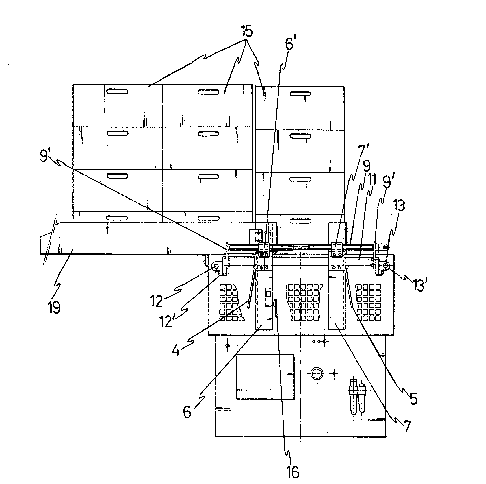Une partie des informations de ce site Web a été fournie par des sources externes. Le gouvernement du Canada n'assume aucune responsabilité concernant la précision, l'actualité ou la fiabilité des informations fournies par les sources externes. Les utilisateurs qui désirent employer cette information devraient consulter directement la source des informations. Le contenu fourni par les sources externes n'est pas assujetti aux exigences sur les langues officielles, la protection des renseignements personnels et l'accessibilité.
L'apparition de différences dans le texte et l'image des Revendications et de l'Abrégé dépend du moment auquel le document est publié. Les textes des Revendications et de l'Abrégé sont affichés :
| (12) Demande de brevet: | (11) CA 2082447 |
|---|---|
| (54) Titre français: | EMPILEUR DE BOITES |
| (54) Titre anglais: | BOX STACKER |
| Statut: | Réputée abandonnée et au-delà du délai pour le rétablissement - en attente de la réponse à l’avis de communication rejetée |
| (51) Classification internationale des brevets (CIB): |
|
|---|---|
| (72) Inventeurs : |
|
| (73) Titulaires : |
|
| (71) Demandeurs : |
|
| (74) Agent: | MARKS & CLERK |
| (74) Co-agent: | |
| (45) Délivré: | |
| (22) Date de dépôt: | 1992-11-09 |
| (41) Mise à la disponibilité du public: | 1994-01-15 |
| Licence disponible: | S.O. |
| Cédé au domaine public: | S.O. |
| (25) Langue des documents déposés: | Anglais |
| Traité de coopération en matière de brevets (PCT): | Non |
|---|
| (30) Données de priorité de la demande: | ||||||
|---|---|---|---|---|---|---|
|
ABSTRACT OF THE DISCLOSURE
This is a box stacker which is related with a box shaping
machine. The boxes come out at the bottom of the machine and
drop by gravity onto a conveyor belt (2) and are conveyed to one
end of this belt (2) where the stacker which is object of this
invention is located. It has upright adjustable guides, two in
front (4 and 5) and two at the rear (6 and 7) which correspond
to the vertical corners of the box, and are at the same time
coupled in pairs to two cross shanks (8 and 9) respectively,
which are in turn coupled at the end to cross shafts (10 and 11)
which are joined by longitudinal screws. The screws turn in
either direction and the upright guides will be adjusted to fit
to the dimensions of the boxes. When one of these lies between
the four upright guides, a pusher (14) goes up and moves the box
to allow room for another one and so on successively. When a
stacked row has been formed, which is automatically counted, it
will be moved by a pusher towards a platform which is formed by
two plates at right angle.
Note : Les revendications sont présentées dans la langue officielle dans laquelle elles ont été soumises.
Note : Les descriptions sont présentées dans la langue officielle dans laquelle elles ont été soumises.

2024-08-01 : Dans le cadre de la transition vers les Brevets de nouvelle génération (BNG), la base de données sur les brevets canadiens (BDBC) contient désormais un Historique d'événement plus détaillé, qui reproduit le Journal des événements de notre nouvelle solution interne.
Veuillez noter que les événements débutant par « Inactive : » se réfèrent à des événements qui ne sont plus utilisés dans notre nouvelle solution interne.
Pour une meilleure compréhension de l'état de la demande ou brevet qui figure sur cette page, la rubrique Mise en garde , et les descriptions de Brevet , Historique d'événement , Taxes périodiques et Historique des paiements devraient être consultées.
| Description | Date |
|---|---|
| Inactive : CIB désactivée | 2017-09-16 |
| Inactive : Symbole CIB 1re pos de SCB | 2017-01-07 |
| Inactive : CIB du SCB | 2017-01-07 |
| Inactive : CIB expirée | 2017-01-01 |
| Inactive : CIB de MCD | 2006-03-11 |
| Demande non rétablie avant l'échéance | 1997-11-10 |
| Le délai pour l'annulation est expiré | 1997-11-10 |
| Réputée abandonnée - omission de répondre à un avis sur les taxes pour le maintien en état | 1996-11-11 |
| Demande publiée (accessible au public) | 1994-01-15 |
| Date d'abandonnement | Raison | Date de rétablissement |
|---|---|---|
| 1996-11-11 |
Les titulaires actuels et antérieures au dossier sont affichés en ordre alphabétique.
| Titulaires actuels au dossier |
|---|
| BOIX MAQUINARIA, S.A. |
| Titulaires antérieures au dossier |
|---|
| JOSE BOIX JAEN |